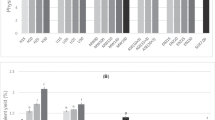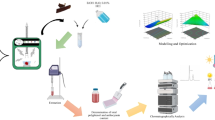Abstract
San Juan is a leading pistachio producer in Argentina. Pistachio industrial processing generates biowastes that can be reused. These biowastes can be used as a precursor of bioactive components of interest as the phenolic compounds. Therefore, the aim of this work is to optimize the conditions of stirring extraction (SE) and ultrasonic-assisted extraction (UAE) of phenolic compounds (PC) using response surface methodology (RSM). A central composite design (CCD) was used to analyze the effects of the independent variables: ethanol:water ratio and extraction time. The optimal conditions for extraction of phenolic compounds from pistachio industry biowaste through UAE method were a volumetric ratio of ethanol:water ratio about 0.5 and an extraction time between 0.7 and 0.94 h. For SE, the optimal conditions were a volumetric ratio of ethanol:water ratio about 0.6 and an extraction time between 2 and 2.7 h. Longer period of extraction, for both extractions UAE and SE, produces degradation reactions and therefore a radical capture activity loss. SE had optimal values of volumetric proportion solvents comparable with those corresponding to UAE. But SE requires more time to produce breaks in the cell, and dissolution and diffusion of bioactive compounds in the extracts.

Graphical abstract



Similar content being viewed by others
References
Caldas TW, Mazza KEL, Teles ASC, Mattos GN, Iraidy A, Brígida S et al (2018) Phenolic compounds recovery from grape skin using conventional and non-conventional extraction methods. Indust Crops Prod 111(May 2017):86–91. https://doi.org/10.1016/j.indcrop.2017.10.012
Chandrasekara A, Shahidi F (2012) Bioaccessibility and antioxidant potential of millet grain phenolics as affected by simulated in vitro digestion and microbial fermentation. J Funct Foods 4(1):226–237. https://doi.org/10.1016/j.jff.2011.11.001
Chandrasekara A, Naczk M, Shahidi F (2012) Effect of processing on the antioxidant activity of millet grains. Food Chem 133(1):1–9. https://doi.org/10.1016/j.foodchem.2011.09.043
Chang C, Yang M, Wen H, Chern J (2002) Estimation of total flavonoid content in propolis by colorimetric methods. J Food Drug Anal 10(3):7802 Retrieved from https://pdfs.semanticscholar.org/b3de/c5e57477b0489135bd5b43a27f9b7cee7d31.pdf
Corrales M, Toepfl S, Butz P, Knorr D, Tauscher B (2008) Extraction of anthocyanins from grape by-products assisted by ultrasonics, high hydrostatic pressure or pulsed electric fields: a comparison. Innov Food Sci Emerg Technol 9(1):85–91. https://doi.org/10.1016/j.ifset.2007.06.002
Fabani MP, Luna L, Baroni MV, Monferran MV, Ighani M, Tapia A, Wunderlin DA, Feresin GE (2013) Pistachio (Pistacia vera var Kerman) from Argentinean cultivars. A natural product with potential to improve human health. J Funct Foods 5(3):1347–1356. https://doi.org/10.1016/j.jff.2013.05.002
Galvan d’Alessandro L, Kriaa K, Nikov I, Dimitrov K (2012) Ultrasound assisted extraction of polyphenols from black chokeberry. Sep Purif Technol 93:42–47. https://doi.org/10.1016/j.seppur.2012.03.024
Garcia-Salas P, Morales-Soto A, Segura-Carretero A, Fernández-Gutiérrez A (2010) Phenolic-compound-extraction systems for fruit and vegetable samples. Molecules 15(12):8813–8826. https://doi.org/10.3390/molecules15128813
Giovinazzo G, Grieco F (2015) Functional properties of grape and wine polyphenols. Plant Foods Hum Nutr 70(4):454–462. https://doi.org/10.1007/s11130-015-0518-1
Granato D, de Araújo Calado VÔM, Jarvis B (2014) Observations on the use of statistical methods in food science and technology. Food Res Int 55:137–149. https://doi.org/10.1016/j.foodres.2013.10.024
Granato D, de Magalhães Carrapeiro M, Fogliano V, van Ruth SM (2016) Effects of geographical origin, varietal and farming system on the chemical composition and functional properties of purple grape juices: a review. Trends Food Sci Technol 52:31–48. https://doi.org/10.1016/j.tifs.2016.03.013
Haas IC d S, Toaldo IM, Burin VM, Bordignon-Luiz MT (2018) Extraction optimization for polyphenolic profiling and bioactive enrichment of extractives of non-pomace residue from grape processing. Ind Crop Prod 112:593–601. https://doi.org/10.1016/j.indcrop.2017.12.058
Heldrich K (1990) Official methods of analysis of the association of official analytical chemists. Association of Official Chemists, Arlington
Hogervorst JC, Miljić U, Puškaš V (2017) Extraction of bioactive compounds from grape processing by-products (C. M. B. T.-H. of G. P. B.-P. Galanakis, ed.). https://doi.org/10.1016/B978-0-12-809870-7.00005-3
Humes, E. (2013). Garbology: Our Dirty Love Affair with Trash. Retrieved from https://books.google.com.ar/books?id=7c6LDQAAQBAJ
Il Rhee J, Diaz Ricci JC, Bode J, Schügerl K (1994) Metabolic enhancement due to plasmid maintenance. Biotechnol Lett 16(9):881–884. https://doi.org/10.1007/BF00128618
Kapoor N, Narain U, Misra K (2007) Bio-active conjugates of curcumin having ester, peptide, thiol and disulfide links. J Sci Ind Res 66:647–650
Karnopp AR, Margraf T, Maciel LG, Santos JS, Granato D (2017) Chemical composition, nutritional and in vitro functional properties of by-products from the Brazilian organic grape juice industry. Int Food Res J 24(1):207–214
Milella RA, Basile T, Alba V, Gasparro M, Giannandrea MA, Debiase G, Genghi R, Antonacci D (2019) Optimized ultrasonic-assisted extraction of phenolic antioxidants from grape (Vitis vinifera L.) skin using response surface methodology. J Food Sci Technol 56(10):4417–4428. https://doi.org/10.1007/s13197-019-03946-9
Niyonizigiye I, Nkurunziza D, Ngabire D, Gitachew AT, Chun BS, Kim GD (2020) Characterization and in vitro cytotoxicity of phytochemicals from Aspilia africana obtained using green extraction techniques. S Afr J Bot 128:231–238. https://doi.org/10.1016/j.sajb.2019.11.013
Özbek HN, Halahlih F, Göğüş F, Koçak Yanık D, Azaizeh H (2018) Pistachio (Pistacia vera L.) hull as a potential source of phenolic compounds: evaluation of ethanol–water binary solvent extraction on antioxidant activity and phenolic content of pistachio hull extracts. Waste Biomass Valoriz 0(0)0 https://doi.org/10.1007/s12649-018-0512-6
Parvathy KS, Negi PS, Srinivas P (2009) Antioxidant, antimutagenic and antibacterial activities of curcumin-β-diglucoside. Food Chem 115(1):265–271. https://doi.org/10.1016/j.foodchem.2008.12.036
Pintać D, Majkić T, Torović L, Orčić D, Beara I, Simin N, Mimica-Dukić N, Lesjak M (2018) Solvent selection for efficient extraction of bioactive compounds from grape pomace. Ind Crop Prod 111:379–390. https://doi.org/10.1016/j.indcrop.2017.10.038
Rajaei B, Barzegar M, Hamidi Z, Sahari MA (2010) Optimization of extraction conditions of phenolic compounds from pistachio (Pistachia vera) green hull through response surface method. J Agr Sci Tech 12:223–231
Rasines-Perea Z, Teissedre PL (2017) Grape polyphenols’ effects in human cardiovascular diseases and diabetes. Molecules 22(1):1–19. https://doi.org/10.3390/molecules22010068
Santos-Buelga (2006) Extraction and isolation of phenolic compounds. Chapter 17. In Natural products isolation (Vol. 864, pp. 1–25). https://doi.org/10.1007/978-1-61779-624-1
SAS Institute (2018) JMP 14 Design of experiments guide. Retrieved from https://books.google.com.ar/books?id=ORVSDwAAQBAJ
Sette P, Fernandez A, Soria J, Rodriguez R, Salvatori D, Mazza G (2020) Integral valorization of fruit waste from wine and cider industries. J Clean Prod 242:118486. https://doi.org/10.1016/j.jclepro.2019.118486
Singh CK, Siddiqui IA, El-Abd S, Mukhtar H, Ahmad N (2016) Combination chemoprevention with grape antioxidants. Mol Nutr Food Res 60(6):1406–1415. https://doi.org/10.1002/mnfr.201500945
Somayajula A, Asaithambi P, Susree M, Matheswaran M (2012) Sonoelectrochemical oxidation for decolorization of Reactive Red 195. Ultrason Sonochem 19(4):803–811. https://doi.org/10.1016/j.ultsonch.2011.12.019
Sun C, Wu Z, Wang Z, Zhang H (2015) Effect of ethanol/water solvents on phenolic profiles and antioxidant properties of Beijing propolis extracts. (September) https://doi.org/10.1155/2015/595393
Wang T, He F, Chen G (2014) Improving bioaccessibility and bioavailability of phenolic compounds in cereal grains through processing technologies: a concise review. J Funct Foods 7:101–111. https://doi.org/10.1016/j.jff.2014.01.033
Zhang Z, Zheng H (2009) Optimization for decolorization of azo dye acid green 20 by ultrasound and H2O2 using response surface methodology. J Hazard Mater 172(2–3):1388–1393. https://doi.org/10.1016/j.jhazmat.2009.07.146
Zhou J, Zheng X, Yang Q, Liang Z, Li D, Yang X, Xu J (2013) Optimization of ultrasonic-assisted extraction and radical-scavenging capacity of phenols and flavonoids from Clerodendrum cyrtophyllum Turcz leaves. PLoS One 8:e68392. https://doi.org/10.1371/journal.pone.0068392
Funding
The authors received support from the following Argentine institutions: Universidad Nacional de SAN JUAN, Argentina (PDTS Res. 1054/18); IDEA (Res. 0279/2019) and CONICET and SECITI-San Juan (PIO-No. 15020150100042CO). Daniela Zalazar has a Doctoral Fellowship from CONICET. Rosa Rodriguez and Gabriela Feresín are Research Members of CONICET.
Author information
Authors and Affiliations
Corresponding author
Additional information
Publisher’s note
Springer Nature remains neutral with regard to jurisdictional claims in published maps and institutional affiliations.
Electronic supplementary material
ESM 1
(DOCX 23 kb)
Rights and permissions
About this article
Cite this article
Zalazar-García, D., Feresin, G.E. & Rodriguez, R. Optimal operational variables of phenolic compound extractions from pistachio industry waste (Pistacia vera var. Kerman) using the response surface method. Biomass Conv. Bioref. 12, 3761–3770 (2022). https://doi.org/10.1007/s13399-020-00862-3
Received:
Revised:
Accepted:
Published:
Issue Date:
DOI: https://doi.org/10.1007/s13399-020-00862-3




